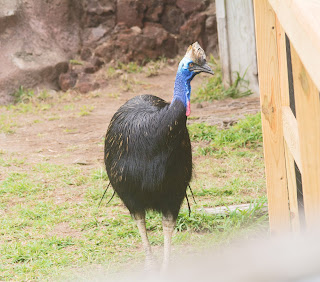The Gladys Porter Zoo is home to approximately 400 animal species and about 250 tropical and neotropical species and subspecies. The zoo opened in 1971 and was donated to the city of Brownsville by the Earl C. Sams Foundation completely planned, built, stocked, and equipped.
Mr. Sams was the President of J.C. Penney and a philanthropist, whose largest project was the Gladys Porter Zoo. Gladys was one of Mr. Sams' two daughters and she had a great concern for the wild animals of the world. She was very closely involved with this project.
In 1980, Mrs. Porter passed away. She had been President of the Board of Directors and proved that one person could make a difference with her outstanding love for animals. The zoo is dedicated to the preservation of nature through education, conservation, and research. It truly is a world class facility and never would have been a reality had it not been for Gladys Porter.
022520
Scarlet Ibis
This bird inhabits tropical South America and the Caribbean Islands. The only non-scarlet parts of its body are the distal third of the outer four primaries, the bill, and the eye, which are all black. It is restricted to the northern third of South America, where its habitat ranges from mangrove swamps, shallow lakes, and anthropogenic wetlands where it feeds generally on crustaceans.
Lesser Whistling Duck
This duck is also known as the Lesser Whistling Teal or Indian Whistling Duck which breeds in southeast Asia and the Indian subcontinent. They feed nocturnally on water plants, cultivated rice grains, frogs, mollusks, and small fish. When waddling about on land, they are frequently followed by the Common Myna on the grass.
Chiloe Wigeon
The Southern Wigeon hails from southern South America, including the Chiloe Archepelago. The species is monogamous. The father helps raise his young, but soon separates from the family when the offspring molt.
Rhinoceros Hornbill
This large species of forest hornbill resides in Asia. The upper part of the bill is known as a casque. The color of both the bill and the casque come from the preen gland oil, which is located above the tail. The eyes of the male are red with black rims, and the female's eyes are white with red rims. This bird is clearly female.
Black Swan
This waterbird breed mainly in the southeast and southwest regions of Australia. There are introduced populations all over the world, as they are very nomadic. Pairs are usually monogamous, and it was recently learned that a third of all broods exhibit extra-pair paternity, while a quarter of all pairs are homosexual, mostly between males. Some will have a temporary extra pairing with a female to obtain eggs, then drive her off.
Cassowary
These flightless birds have no keel and are native to the tropical forest of New Guinea to northeastern Australia. They subsist mainly on fruit, and are very wary of humans, whereby they can inflict serious injuries if provoked or even death. This may make them the most dangerous bird. These shy individuals are found in the deep forest. They have a keratinous skin-covered casque on the head that gets larger with age and is hollow, believed to have an acoustic function to amplify sound. Cassowaries are keystone species of rainforests, as they eat fallen fruit whole, and reseed the jungle floor. The average lifespan of wild birds is 40-50 years.
The female will not care for the eggs or chicks. She will just move on in her territory to lay eggs in the nests of multiple males, leaving the responsibility of care to him.
Arabian Oryx
This medium-sized antelope has a distinct shoulder bump out, tufted tail, and long, thin, straight horns. The white oryx can detect rain and will head in that direction, which means that their range is tremendous. They simply follow the trail of fresh plant growth. Their only predator is the wolf, and they are susceptible to malnutrition and dehydration. Fights, drowning during floods, snakebites, and disease also take a toll on these ungulates. Their horns are hollow, so if one is lost, it cannot be regrown due to the lack of blood supply.
This species was saved from extinction through several world zoos (including the Phoenix Zoo) under the auspices of the World Wildlife Fund in 1962. Starting with nine animals, Phoenix Zoo had over 240 births. They relocated animals to other zoos and parks to begin new herds.
Muscovy
This tree cavity nester originated in Central America and Mexico expanding to Texas in the 1980s. There are several feral populations in the US, and it can thrive under very cold conditions, even as a tropical bird.
There are also domestic muscovy ducks, which also explain pure white birds and and other mixed coloring with black.
Red-crowned Parrot
This bird is wild, even though it is located at the zoo. There are several feral populations in northwest Mexico, Texas, and southeast Arizona. This endangered Amazon parrot is decreasing in population, even in established sites due to loss of habitat, the illegal pet trade, and illegally trapped birds from Mexico.
Gathering in large flocks from early morning to evening, these parrots are at their most noisy stage. They nest in tree cavities and roost in trees overnight. They reach sexual maturity at the age of five.










No comments:
Post a Comment